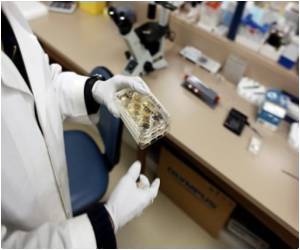An experimental drug for melanoma has successfully shrank tumors that spread to the brain in nine out of 10 patients in part of an international phase I clinical trial.

"Nine out of 10 responses among patients with brain metastases is really exciting. No other systemic therapy has ever demonstrated this much activity against melanoma brain metastases," said study co-lead author Gerald Falchook, M.D., assistant professor in the Department of Investigational Cancer Therapeutics at The University of Texas MD Anderson Cancer Center.
Melanoma patients whose disease has spread to their brains have a median overall survival of four or five months, the researchers noted. Drugs used to treat brain metastases have response rates of 10 percent or lower. Surgery and stereotactic or whole-brain radiation also are used.
Tumor shrinkage in the nine responders ranged from 20 percent to 100 percent. In four cases, the brain metastases disappeared.
Drug's reach into brain a surprise
These results will need to be validated in additional clinical trials with larger groups of patients, Falchook said. "This changes how we think of this drug and exclusion criteria for future trials."
Advertisement
Dabrafenib, made by GlaxoSmithKline, was not designed to cross the blood-brain barrier, which protects the brain from toxic substances in the blood.
The team then designed a sub-study for 10 patients with untreated brain metastases, Falchook said. The mechanism by which dabrafenib reaches tumors in the brain is under investigation.
"In all of these patients with melanoma brain metastases, the tumors eventually progressed," Falchook said. Prevention of drug resistance remains a challenge in advanced cancers.
High response rate for those without brain metastases
184 patients enrolled at eight sites in the United States and Australia. Of these, 156 patients had melanoma that had spread to other organs. MD Anderson enrolled 64 patients.
The main purpose of a phase I clinical trial is to gradually escalate an experimental drug's dosage to evaluate side effects and establish the highest possible dose that can be safely given.
The researchers never reached a maximum-tolerated dose limit. No patients had to discontinue the drug due to side effects, and few patients experienced severe toxicity. "This is a very non-toxic drug, which is common with these newer, targeted therapies," Falchook said.
Based on response rates and the drug's pharmacokinetics – how the body metabolizes it – the team recommended an oral dose of 150 mg twice daily for future phase II and phase III trials. In the second stage of the phase I trial, they tested that dose in:
- 36 patients with melanoma with the Val600 BRAF mutation without brain metastases,
- 10 patients with untreated melanoma brain metastases, and
- 28 patients with other BRAF-mutant cancers.
Among the 36 melanoma patients without untreated brain metastases:
- 25 (69 percent) had a partial or complete response, which is shrinkage of at least 30 percent as determined by measuring tumor shrinkage with radiographic imaging,
- 18 (50 percent) had a confirmed response, meaning the reduction in size was observed in a second imaging scan at least one month later,
- 17 (47 percent) stayed on the trial for more than six months, and.
- Responses were seen in the less common Val600Lys BRAF mutation.
The confirmed response rate was similar to that in a phase III study of vemurafenib, the first drug approved for treatment of BRAF-mutant melanoma.
Among those with other types of cancers, patients with papillary thyroid, non-small cell lung and colorectal cancers had partial responses.
"This is further evidence that a tumor's molecular profile is as important, and possibly more important, than the organ where the cancer begins," Falchook said.
"We need to screen for BRAF and other molecular abnormalities in our patients' tumors," he said. "In many other tumor types BRAF mutations occur in small percentages of patients. If we're not testing for it routinely, these patients might never be treated with a promising targeted agent for their cancer."
Falchook has six melanoma patients still receiving dabrafenib, including five who are in complete remission. In addition, Falchook is still treating six papillary thyroid patients and one colorectal cancer patient whose tumors have not progressed on the treatment.
Source-Eurekalert












